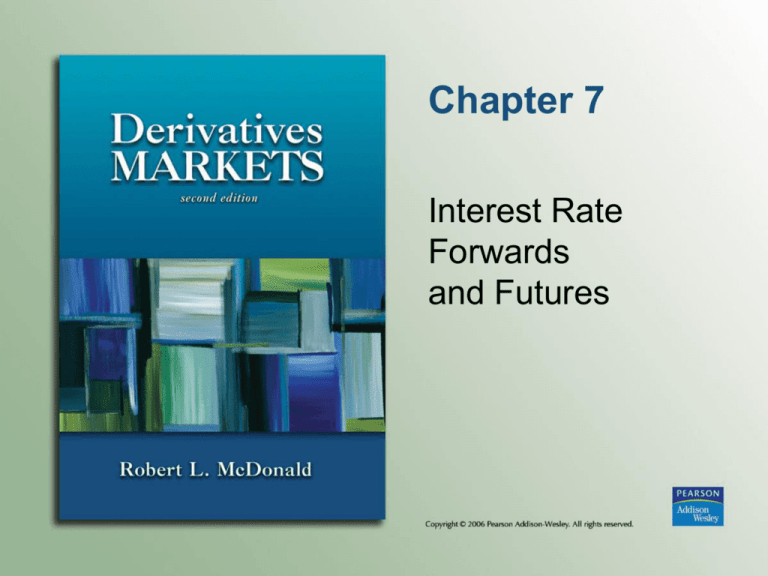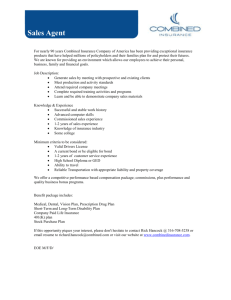
Chapter 7
Interest Rate
Forwards
and Futures
Bond Basics
• U.S. Treasury
Bills (<1 year), no coupons, sell at discount
Notes (1–10 years), Bonds (10–30 years),
coupons, sell at par
STRIPS: claim to a single coupon or
principal, zero-coupon
Copyright © 2006 Pearson Addison-Wesley. All rights reserved.
7-2
Bond Basics (cont’d)
• Notation
rt (t1,t2): interest rate from time t1 to t2
prevailing at time t
Pto(t1,t2): price of a bond quoted at t= t0 to
be purchased at t=t1 maturing at t= t2
Yield to maturity: percentage increase in
dollars earned from the bond
Copyright © 2006 Pearson Addison-Wesley. All rights reserved.
7-3
Bond Basics (cont’d)
• Zero-coupon bonds make a single payment
at maturity
One year zero-coupon bond: P(0,1)=0.943396
• Pay $0.943396 today to receive $1 at t=1
• Yield to maturity (YTM) = 1/0.943396 - 1 = 0.06 = 6% = r (0,1)
Two year zero-coupon bond: P(0,2)=0.881659
• YTM=1/0.881659 1=0.134225=(1+r(0,2))2=>r(0,2)=0.065=6.5%
Copyright © 2006 Pearson Addison-Wesley. All rights reserved.
7-4
Bond Basics (cont’d)
Ct
• Zero-coupon bond price that pays Ct at t: P(0,t)
[1 r(0,t)]t
• Yield curve: graph of annualized bond yields
against time
• Implied forward rates
Suppose current one-year rate r(0,1) and two-year rate r(0,2)
Current forward rate from year 1 to year 2, r0(1,2), must satisfy
[1 r0 (0,1)][1 r0 (1,2)] [1 r0 (0,2)]2
Copyright © 2006 Pearson Addison-Wesley. All rights reserved.
7-5
Bond Basics (cont’d)
Copyright © 2006 Pearson Addison-Wesley. All rights reserved.
7-6
Bond Basics (cont’d)
• In general
t 2 t1
[1 r0 (t1 , t2 )]
[1 r0 (0, t2 )]t
P(0, t1 )
P(0, t2 )
[1 r0 (0, t1 )]t
2
1
• Example 7.1
What are the implied forward rate r0(2,3) and
forward zero-coupon bond price P0(2,3) from
year 2 to year 3? (use Table 7.1)
P(0,2)
0.881659
r0 (2,3)
1
1 0.0800705
P(0,3)
0.816298
P0 (2,3)
P(0,3) 0.816298
0.925865
P(0,2) 0.881659
Copyright © 2006 Pearson Addison-Wesley. All rights reserved.
7-7
Bond Basics (cont’d)
• Coupon bonds
The price at time of issue of t of a bond maturing at time T that
pays n coupons of size c and maturity payment of $1
n
Bt (t,T,c,n) cPt (t , ti ) Pt (t , T )
i 1
where ti = t + i(T - t)/n
For the bond to sell at par the coupon size must be
c
Copyright © 2006 Pearson Addison-Wesley. All rights reserved.
1 Pt (t , T )
n
P (t , ti )
i 1 t
7-8
Forward Rate Agreements
• FRAs are over-the-counter contracts that guarantee
a borrowing or lending rate on a given notional
principal amount
• Can be settled at maturity (in arrears) or the initiation
of the borrowing or lending transaction
FRA settlement in arrears: (rqrtly- rFRA) x notional principal
At the time of borrowing:
notional principal x (rqrtly- rFRA)/(1+rqrtly)
• FRAs can be synthetically replicated using
zero-coupon bonds
Copyright © 2006 Pearson Addison-Wesley. All rights reserved.
7-9
Forward Rate Agreements (cont’d)
Copyright © 2006 Pearson Addison-Wesley. All rights reserved.
7-10
Eurodollar Futures
• Very similar in nature to an FRA with subtle differences
The settlement structure of Eurodollar contracts favors borrowers
Therefore the rate implicit in Eurodollar futures is greater than the
FRA rate => Convexity bias
• The payoff at expiration: [Futures price – (100 – rLIBOR)] x
100 x $25
• Example: Hedging $100 million borrowing with Eurodollar futures:
Copyright © 2006 Pearson Addison-Wesley. All rights reserved.
7-11
Eurodollar Futures (cont’d)
• Recently Eurodollar futures took over T-bill futures as
the preferred contract to manage interest rate risk
• LIBOR tracks the corporate borrowing rates better
than the T-bill rate
Copyright © 2006 Pearson Addison-Wesley. All rights reserved.
7-12
Interest Rate Strips and Stacks
• Suppose we will borrow $100 million in 6
months for a period of 2 years by rolling
over the total every 3 months
r1=?
0
r2=?
r3=?
r4=?
r5=?
r6=?
r7=?
r8=?
6
9
12
15
18
21
24
27
$100
$100
$100
$100
$100
$100
$100
$100
Copyright © 2006 Pearson Addison-Wesley. All rights reserved.
7-13
Interest Rate Strips and Stacks (cont’d)
• Two alternatives to hedge the interest rate risk
Strip: eight separate $100 million FRAs for each
3-month period
Stack: enter 6-month FRA for ~$800 million. Each
quarter enter into another FRA decreasing the total
by ~$100 each time
Strip is the best alternative but requires the
existence of FRA far into the future. Stack is more
feasible but suffers from basis risk
Copyright © 2006 Pearson Addison-Wesley. All rights reserved.
7-14
Duration
• Duration is a measure of sensitivity of a bond’s price
to changes in interest rates
Duration
Change in bond price
1 n
Ci
i
Unit change in yield
1 y i 1 (1 y)i
$ Change in price for
a unit change in yield
divide by 10 (10,000) for change in price given
a 1% (1 basis point) change in yield
Modified Duration
% Change in price for
a unit change in yield
1
1 n Ci
1
Duration
i
B( y ) 1 y i 1 (1 y )i B( y)
Macaulay Duration
Size-weighted average
of time until payments
1 y n Ci
1
Duration
i
B( y ) i 1 (1 y )i B( y)
y: yield per period; to annualize divide by # of
payments per year
B(y): bond price as a function of yield y
Copyright © 2006 Pearson Addison-Wesley. All rights reserved.
7-15
Duration (cont’d)
• Example 7.4 & 7.5
3-year zero-coupon bond with maturity value of $100
• Bond price at YTM of 7.00%: $100/(1.07003)=$81.62979
• Bond price at YTM of 7.01%:
• Duration:
D=-$0.02288
$100/(1.07013)=$81.60691
1
$100
3
$228.87
3
107
.
107
.
• For a basis point (0.01%) change: -$228.87/10,000=-$0.02289
• Macaulay duration:
( $228.87)
• Example 7.6
107
.
3.000
$81.62979
3-year annual coupon (6.95485%) bond
• Macaulay Duration:
(1
0.0695485
0.0695485
10695485
.
) (2
)
(
3
) 2.80915
2
3
10695485
.
10695485
.
10695485
.
Copyright © 2006 Pearson Addison-Wesley. All rights reserved.
7-16
Duration (cont’d)
• What is the new bond price B(y+) given a
small change in yield?
Rewrite the
[B ( y ) B ( y )] 1 y
Macaulay duration DMac
And rearrange
Copyright © 2006 Pearson Addison-Wesley. All rights reserved.
B( y )
B( y)
B ( y ) B ( y ) [ DMac
]
1 y
7-17
Duration (cont’d)
• Example 7.7
Consider the 3-year zero-coupon bond with price
$81.63 and yield 7%
What will be the price of the bond if the yield were
to increase to 7.25%?
B(7.25%) = $81.63 – ( 3 x $81.63 x 0.0025 / 1.07 )
= $81.058
Using ordinary bond pricing: B(7.25%) = $100 /
(1.0725)3 = $81.060
• The formula is only approximate due to the
bond’s convexity
Copyright © 2006 Pearson Addison-Wesley. All rights reserved.
7-18
Duration (cont’d)
• Duration matching
Suppose we own a bond with time to maturity t1, price B1,
and Macaulay duration D1
How many (N) of another bond with time to maturity t2, price
B2, and Macaulay duration D2 do we need to short to eliminate
sensitivity to interest rate changes? The hedge ratio
The value of the resulting portfolio
D B ( y ) / (1 y1 )
N 1 1 1
with duration zero is B1+NB2
D2 B2 ( y2 ) / (1 y2 )
• Example 7.8
We own a 7-year 6% annual coupon bond yielding 7%
Want to match its duration by shorting a 10-year, 8% bond
yielding 7.5%
You can verify that B1=
5882
.
94.611 / 107
.
$94.611, B2=$103.432,
N
0.7409
7
.
297
103
.
432
/
1075
.
D1=5.882, and D2=7.297
Copyright © 2006 Pearson Addison-Wesley. All rights reserved.
7-19
Treasury Bond/Note Futures
• WSJ listings for
T-bond and
T-note futures
• Contract
specifications
Copyright © 2006 Pearson Addison-Wesley. All rights reserved.
7-20
Treasury Bond/Note Futures (cont’d)
• Long T-note futures position is an obligation to buy a 6% bond
with maturity between 6.5 and 10 years to maturity
• The short party is able to choose from various maturities and
coupons: the “cheapest-to-deliver” bond
• In exchange for the delivery the long pays the short the
“invoice price.”
Price of the bond if it were to yield 6%
Invoice price = (Futures price x conversion factor) + accrued interest
Copyright © 2006 Pearson Addison-Wesley. All rights reserved.
7-21
Repurchase Agreements
• A repurchase agreement or a repo entails selling
a security with an agreement to buy it back at a
fixed price
• The underlying security is held as collateral by the
counterparty => A repo is collateralized borrowing
• Frequently used by securities dealers to
finance inventory
• Speculators and hedge funds also use repos to
finance their speculative positions
• A “haircut” is charged by the counterparty to account
for credit risk
Copyright © 2006 Pearson Addison-Wesley. All rights reserved.
7-22






